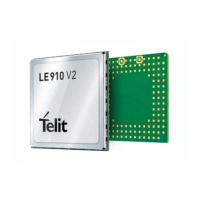Telit LE910 V2 Series AT Commands
80446ST10707A Rev. 0– 2015-11-03
Reproduction forbidden without Telit Communications S.p.A. written authorization - All Rights Reserved page 365 of 509
Mod. 0808 2011-07 Rev.2
Manage the security data - #SSLSECDATA
#SSLSECDATA – Manage the security data
=<SSId>,<Action>,
<DataType>[,<Size>]
This command allows to store, delete and read security data
(Certificate, CAcertificate, private key) into NVM.
Parameters:
<SSId> - Secure Socket Identifier
1 - Until now SSL block manages only one socket.
<Action> - Action to do.
0 – Delete data from NVM.
1 – Store data into NVM.
2 – Read data from NVM .
<DataType>
0 – Certificate
1 – CA certificate
2 - RSA Private key
<Size> - Size of security data to be stored
1..4000
If the <Action> parameter
is 1 (store data into NVM) the device responds to the
command with the prompt ‘>’ and waits for the data to store.
Note: secured data have to be in PEM or in DER format,
depending on < cert_format > chosen with #SSLSECCFG.
If no < cert_format> has been specified with #SSLSECCFG,
PEM format is assumed.
PEM format(see #SSLSECCFG command):To complete the operation send Ctrl-
Z char (0x1A hex); to exit without writing the message send ESC char (0x1B hex).
DER format(see #SSLSECCFG command)::
When <size> bytes are entered, the certificate is automatically stored.
ESC or Ctrl-Z don’t take effect, because
they are considered as possible octets
contained in the certificate.
If data are successfully stored, then the response is OK; if it fails for some reason,
an error code is reported.
If the <Action>
parameter is 2 (read data from NVM), data specified by
<DataType> parameter is shown in the following format:
#SSLSECDATA: <connId>,<DataType>
<DATA>

